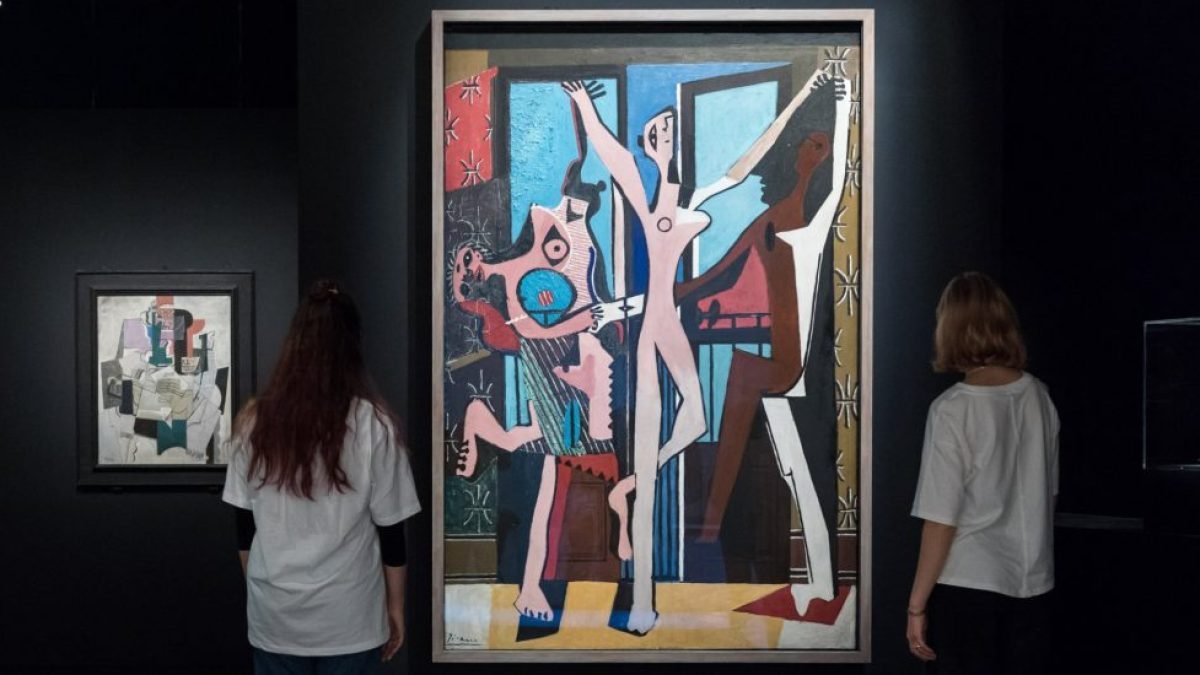
In the summer of 1960, London’s Tate Gallery staged the first “art blockbuster”, and Picassomania hit Britain. It was a curious prelude to the Beatlemania that would sweep the country three years later: visitors fainted, warders suffered nervous collapse, petrol stations sold PicESSO, and the Duke of Edinburgh – not known for his love of modern art – made a visit.
The exhibition was the biggest Picasso retrospective to date, regularly attracting 10,000 visitors a day. The excitement was such that the Queen and Princess Margaret came to see for themselves, an occasion recorded in hurried notes preserved in the Edinburgh Archive. There is no record of the royal response to The Three Dancers, (1925), one of the show’s highlights and now the focus of Tate Modern’s Theatre Picasso – an exhibition, which opens today, celebrating the painting’s centenary year, and the 25th anniversary of Tate Modern, where it is a perennially popular work.
Instead, a note states, “Pigeons much admired”, while elsewhere the Queen asks, not unreasonably, why he puts two eyes on the same side of a face. They must have been absorbed by it, because the Duke of Edinburgh comes in, to say: “DO realise, Darling, there are 270 pictures to see and we have hardly begun.”

Despite his fascination for Princess Margaret, Picasso himself stayed away: “Why should I waste my time going to see my paintings again? I have a good memory, and I remember all of them”, he wrote to the exhibition’s organiser Roland Penrose, who reported back in great excitement: “You have conquered London.”
It had been a long time coming: despite being an established global superstar, Picasso was not yet a household name in Britain, and though it pales next to his current image problem as a flag-bearer for toxic masculinity, it is remarkable to think that as Pop Art hit America, in the UK, the exotic and avant-garde Picasso was still something of a novelty.
Though resident at Tate Modern since 2000, The Three Dancers has been in Tate’s collection since 1965, when it was acquired with enormous fanfare – and quite some controversy – direct from the artist himself, as a remarkable (and remarkably expensive) memento of the 1960 retrospective.
The acquisition, brokered by Penrose, was an extraordinary coup, explains curator Natalia Sidlina, and required parliamentary approval: “At the time, it was a unique event because it was the first painting Picasso personally sold to a museum. Picasso had dealers from day one – in 1901, when he was nobody, he was already represented by Ambroise Vollard.”
The Three Dancers was no ordinary painting, either: along with Guernica, (1937), and Les Demoiselles d’Avignon, (1907), it is one of Picasso’s most important works, a personal and artistic landmark of such significance that it was believed to be closely guarded by the artist for 40 years after its creation.

Its title is deceptively simple: three dancers, two of them certainly female, are framed against an open window, the brilliant blue of a Mediterranean sky behind them. But each of the dancers is uniquely strange, and the picture shifts restlessly between the violently joyful, brutal, portentous, and serene.
Almost as soon as it was completed, the painting’s surrealist credentials were cemented when it was reproduced in André Breton’s La Révolution Surréaliste. The Surrealist shift underscored his continued relevance in the febrile aftermath of the First World War, when Picasso was himself working in two distinct styles, the playful subversions of synthetic Cubism, in which bold colours and flattened forms complicate our perception of space, contrasting with the Neoclassical tendencies of his figure paintings, such as Seated Woman in a Chemise, 1923.
The Three Dancers owes something to both of these strands of work – the bright colours, and cut-out, collage-like figures an echo of The Three Graces of classical mythology, a subject that he had reprised two years earlier, as part of a set design for the ballet Mercure.

Picasso was immersed in dance in the years following the First World War. In 1917, he began working with Diaghilev’s Ballets Russes, designing the costumes and sets for Parade, a one-act ballet with music by Erik Satie, and devised by Jean Cocteau. It was during rehearsals for Parade that he met the Russian ballerina Olga Khokhlova, whom he married in 1918.
His involvement with the Ballets Russes continued for several years, but Picasso’s interests extended beyond classical dance, to the flamenco of his native Spain, and to Margaret Morris’s avant-garde dance school, which he encountered in 1923, while on holiday with Olga and their family in the south of France. Picasso later said that the Margaret Morris School “couldn’t dance at all”, but he was undoubtedly fascinated by them, according to dancer Hélène Vanel, who later wrote: “He didn’t speak but watched. His look was intense, dark and brilliant. I wondered what he was thinking. Perhaps he was interested in our combinations of abstract shapes. It had very little in common with his wife Olga’s dancing, or with ballet in general”.
Like Picasso’s 1907 painting, Les Demoiselles d’Avignon, The Three Dancers reinforces the association of dance with primal urges and unfettered emotion by connecting it to the racial stereotypes of the day, which typically identified so-called “primitive” cultures as free from the constraints of Western “civilisation”. Here, such characterisations supply a visual shorthand for the wild, even malevolent energy that animates these figures, especially the dancer on the left, whose serrated edges and double face recall the African sculptures that Picasso, and many of his peers, were fascinated by.

Revered as one of “Picasso’s Picassos”, Sidlina says that the painting’s interpretation and history has rested almost entirely on the artist’s own remarks, including a comment to Penrose that the painting ought to have been called The Death of Pichot, since he heard of the death of his friend, the painter Ramon Pichot, while he was working on it. As a result, the “shadow” figure behind the dancer on the right is understood to represent Pichot. Similarly, the dancer on the left is often identified either as Germaine Gargallo, the victim of an attempted murder-suicide by a mutual friend of Picasso and Pichot, or, alternatively, as Olga Khokhlova.
Such layers of personal meaning all contribute to the painting’s power, but it is the loan history that reveals the force of Picasso’s personal mythology, which made Tate’s acquisition of the painting such an unparalleled triumph.
New research by Sidlina shows that far from remaining among Picasso’s most treasured personal possessions for all those years, The Three Dancers was sent to the Museum of Modern Art, New York, in 1939, where it featured in his first US retrospective, and there remained for 19 years.

Perhaps events in Europe were a distraction, but Sidlina says: “This isn’t a hidden history – it’s just that no one paid attention, blinded by the idea of the work coming straight from Picasso’s private stash.”
In fact, Picasso boasted to Penrose about just how many people had tried to prise the painting away from him, saying: “I have been asked a hundred times to sell it… but I have always refused.” It’s an age-old tactic, and Sidlina says that Penrose joked that it had taken him five years to persuade the artist to sell the work. “In the end, Penrose wanted to acquire it a tiny little bit more than Picasso didn’t want to sell it.”
In the 19 years it spent in New York, The Three Dancers acquired an entirely new context. It was never exhibited with any Surrealist works, says Sidlina, and instead “it was juxtaposed with works by artists such as Jackson Pollock, Roberto Matta, and David Alfaro Siqueiros… It was understood for its monumental power as one of the works which bridged painting and Mexican muralism.”
Now, to celebrate its centenary, the stage is set for the next phase in its story.
‘Theatre Picasso‘ is at the Tate Modern until 12 April











